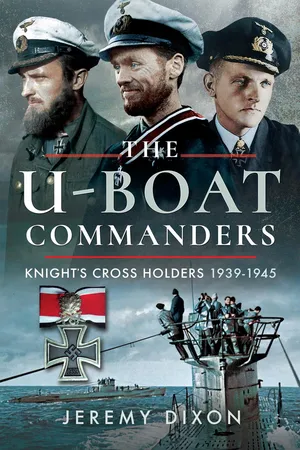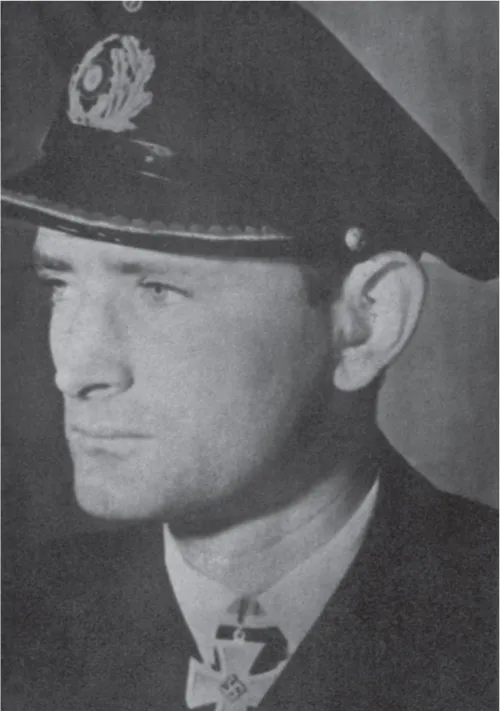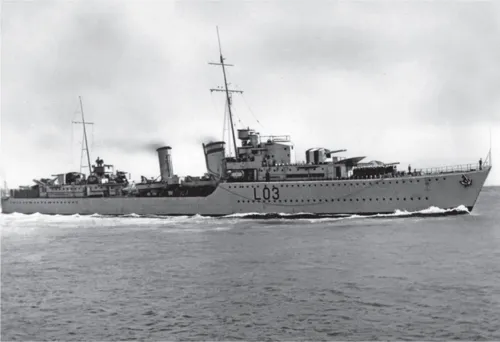
- 336 pages
- English
- ePUB (mobile friendly)
- Available on iOS & Android
eBook - ePub
About this book
This illustrated WWII reference guide presents detailed profiles of Nazi U-Boat commanders who were awarded the Knight's Cross.
The Knight's Cross—or Ritterkreuz—was one of the highest decorations given for acts of valor among the German armed forces during the Second World War. When a U-boat captain was awarded the decoration, it was source of pride for his entire crew. Sometimes it was even added to the boat's insignia. In all, there were 123 recipients. In The U-Boat Commanders, Jeremy Dixon provides a highly illustrated guide to all these men and their wartime service.
A detailed text accompanied by almost 200 archive photographs describes the military careers of each U-Boat Commander, including those who received the higher grades of the award. Full details are given of their tours of duty, the operations they took part in, how they won their award, how many ships they sank, and their subsequent careers.
The Knight's Cross—or Ritterkreuz—was one of the highest decorations given for acts of valor among the German armed forces during the Second World War. When a U-boat captain was awarded the decoration, it was source of pride for his entire crew. Sometimes it was even added to the boat's insignia. In all, there were 123 recipients. In The U-Boat Commanders, Jeremy Dixon provides a highly illustrated guide to all these men and their wartime service.
A detailed text accompanied by almost 200 archive photographs describes the military careers of each U-Boat Commander, including those who received the higher grades of the award. Full details are given of their tours of duty, the operations they took part in, how they won their award, how many ships they sank, and their subsequent careers.
Frequently asked questions
Yes, you can cancel anytime from the Subscription tab in your account settings on the Perlego website. Your subscription will stay active until the end of your current billing period. Learn how to cancel your subscription.
At the moment all of our mobile-responsive ePub books are available to download via the app. Most of our PDFs are also available to download and we're working on making the final remaining ones downloadable now. Learn more here.
Perlego offers two plans: Essential and Complete
- Essential is ideal for learners and professionals who enjoy exploring a wide range of subjects. Access the Essential Library with 800,000+ trusted titles and best-sellers across business, personal growth, and the humanities. Includes unlimited reading time and Standard Read Aloud voice.
- Complete: Perfect for advanced learners and researchers needing full, unrestricted access. Unlock 1.4M+ books across hundreds of subjects, including academic and specialized titles. The Complete Plan also includes advanced features like Premium Read Aloud and Research Assistant.
We are an online textbook subscription service, where you can get access to an entire online library for less than the price of a single book per month. With over 1 million books across 1000+ topics, we’ve got you covered! Learn more here.
Look out for the read-aloud symbol on your next book to see if you can listen to it. The read-aloud tool reads text aloud for you, highlighting the text as it is being read. You can pause it, speed it up and slow it down. Learn more here.
Yes! You can use the Perlego app on both iOS or Android devices to read anytime, anywhere — even offline. Perfect for commutes or when you’re on the go.
Please note we cannot support devices running on iOS 13 and Android 7 or earlier. Learn more about using the app.
Please note we cannot support devices running on iOS 13 and Android 7 or earlier. Learn more about using the app.
Yes, you can access The U-Boat Commanders by Jeremy Dixon in PDF and/or ePUB format, as well as other popular books in History & Military & Maritime History. We have over one million books available in our catalogue for you to explore.
Information
Knight’s Cross

Albrecht Adolf Konrad ACHILLES
Korvettenkapitän
14 ships sunk, 64,542 tons
6 ships damaged, 41,122 tons
Knight’s Cross: Awarded on 16 January 1943, as Kapitänleutnant and as commander of U-181, in recognition of his success in sinking eleven ships, including the British tanker Circe Shell, the South African whale factory ship Uniwaleco and the lighthouse tender USS Acacia.
Albrecht Achilles was born on 25 January 1914, in Karlsruhe, entering the Kriegsmarine in April 1934. He served on the battleship Schleswig-Holstein before attending various training courses at the Cadet Naval College at Flensburg-Mürwik in 1935, and three years later he served on board the battleship Gneisenau as a signals officer. Achilles was commissioned as a Leutnant zur See in April 1937 and was promoted to Oberleutnant zur See on 13 April 1939.
In April 1940, he attended a U-boat officer’s course, and later joined the U-boat training battalion at Plön. In November Achilles served on U-66 whilst it was still under construction – enabling him to familiarize himself with the boat before it became operational. In January 1941, he was appointed Watch Officer and served during three patrols, under the command of Korvettenkapitän Richard Zapp. He was promoted to Kapitänleutnant in August 1941 and on 1 January 1942, Achilles was appointed commander of U-181, and would complete six patrols and be credited with fourteen ships sunk for a total of 64,542 shipping tons. On 24 January U-181 left Lorient for the Caribbean, and on the night of 18/19 February torpedoed the SS Mokihana and the British tanker SS British Consul, both of which were damaged. On 21 February Achilles sank his first ship, the British tanker MV Circe Shell, during an evening attack near the Port of Spain, Trinidad. On 7 March he sank the South African whale factory ship the Uniwaleco. She was struck by one of two torpedoes about 45 miles west of St. Vincent Passage. The ship apparently went out of control because she ran in circles and settled but did not sink. A third torpedo was fired and finished her off; she sank within three minutes after breaking in two. Eighteen crew members were lost. Achilles attacked two ships and damaged both, the Canadian passenger ship Lady Nelson and the British steamer Umtata, on 10 March. Lady Nelson caught fire by the stern in shallow water whilst in the harbour of Port Castries, St. Lucia, with the loss of twenty-five crew. On the 14th Achilles sank the Canadian steamer Sarniadoc about 200 miles west of Guadeloupe. She was hit by a single torpedo and sank within thirty seconds after her boiler exploded, with the loss of her master and all of her crew. The next day he sank the lighthouse tender USCGC Acacia which was shelled by U-181 from her deck guns and caught fire and sank by the stern about 80 miles south-west of Saint Kitts and Nevis. The survivors were rescued by USS Overton and landed at San Juan on 16 March.

(Scherzer)
He began his third patrol on 28 April 1942, heading for the Atlantic in the company of U-126 and U-128. On 11 May they encountered the northbound Convoy SL109 about 220 miles north-west of the Cape Verde Islands. The convoy was shadowed but only U-126 and U-128 made attacks. The three boats continued on to waters north of Brazil and then along the Brazilian coast. By mid-June U-181 was in the eastern Caribbean and later moved eastwards towards the harbour of Porto Limon, Costa Rica where it sank the Panamanian SS San Pablo tied up at the pier. Achilles then patrolled along the coast of Panama before leaving the Caribbean and later attacked a convoy off Bermuda sinking the American SS Fairport. He thren headed for Lorient, arriving on 7 August. In late Septmeber he headed out again on his next patrol where he carried out a reconnaissance of the Gulf of Guinea and the Congo Delta, following reports of shipping activity in those areas. From 20 October Achilles was stationed off the Congo when on the 23rd he torpedoed and dmaged the British cruiser HMS Phoebe off Pointe Noire. Few ships were then seen and Achilles took U-181 north to the Gulf of Guinea in search for more targets. On the evening of 8 November he sank the American SS West Humhaw, 60 miles south-west of Takoradi and on the 29th he sank the Dutch steamer Tjileboet with the loss of the entire crew. In March 1943, during the boat’s fifth patrol in the North Atlantic together with U-174, it met the German ship Regensberg and later the Italian ship Pierto Orseolo, and headed for the US east coast. They patrolled from east of New York up to an area south of Nova Scotia where he sank the Canadian sailing ship Angelus by gunfire north of Bermuda after her crew of ten had abandoned ship in a lifeboat. When the boat was found after five days by the destroyer USS Turner, only two survivors were found alive: the others including the master had died from exposure.

HMS Phoebe was assigned to the 15th Cruiser Squadron in September 1940, as part of the Home Fleet and employed in the North Atlantic on trade protection duties. In April 1941, she joined the Mediterranean Fleet at Alexandria from where she took part in the evacuation of Greece and Crete. She returned to Alexandria on 29 May with New Zealand troops evacuated from Crete, but was sent back to Crete to evacuate as many as possible of the remaining New Zealand and Australian solders before Crete capitulated. She was attacked by an Italian aircraft on 27 August 1941 and damaged while covering troop transports to the besieged Tobruk, and had to be repaired. She returned to service in May 1942 and on 23 October was struck by two torpedoes from U-161 and was seriously damaged. She was repaired and returned to active service in August 1943. (Author’s collection)
In August 1943, during his sixth patrol, Achilles had a special task to perform. He was ordered to rendezvous with the Japanese submarine I-8 south of the Azores. Two German officers were put aboard I-8 with radar equipment. Achilles then continued with his patrol and headed to the coast of Brazil. The boat moved north-westwards towards the Säo Francisco River, Brazil where on 26 September it sank the SS Itapagé. That same evening, U-181 was attacked by a United States Navy Mariner, based at Aratu. It crash-dived and made its escape. The following day it wasn’t so lucky, it was hit by depth charges and sank: there were no survivors. Achilles was posthumously promoted to Korvettenkapitän on 5 April 1945.
Other awards:
08 Apr 1938: Long Service Award 4th Class
15 Jul 1941: High Seas Fleet Badge
07 Aug 1941: Iron Cross 2nd Class
07 Aug 1941: U-boat War Badge
5 Apr 1942: Iron Cross 1st Class
Klaus Heinrich BARGSTEN
Kapitänleutnant
5 ships sunk, 22,171 tons
Knight’s Cross: Awarded as Kapitänleutnant and as commander of U-521, on 30 April 1943, in recognition of sinking 22,171 shipping tons, five ships in total including one warship.
Klaus Bargsten was born in Bad Oldesloe, Schleswig-Holstein in Germany on 31 October 1911, and after completing his schooling trained as an officer in the merchant service and was later employed by North German Lloyd Steamship Company. He joined the Naval Academy at Flensburg in 1935, and was appointed an Officer Candidate with a training battalion in the Baltic Sea in April 1936. He was accepted into the Naval School at Flensburg-Mürwik in March 1937. He was commissioned as a Leutnant zur See in April 1938 and was serving at the Naval Training School in Neutstadt when the Second World War started. Promoted to Oberleutnant zur See on 1 October 1939, Bargsten briefly served as a Watch Officer on board U-6, before being transferred to U-99, where he served until February 1941 under Korvettenkapitän Otto Kretschmer – who would become one of the most successful U-boat commanders of the war. He took part in seven patrols whilst attached to U-99 and Kretschmer claimed a total of thirty ships for a total of 235,000 shipping tons. Bargsten was learning how to be a successful commander from one of the best!

(Wehrkundearchiv)
In March 1941, he became the commander of U-563. His first two patrols were uneventful. His third patrol, which began on 31 July 1941, was in the North Atlantic. His boat became one of a number of U-boats which were operating around Iceland. On 12 August, U-129 sighted a convoy and U-563, U-206 and U-567 were directed to it, but failed to find it. On 4 October, Bargsten set-out on his fourth patrol, again in the Atlantic and was directed to a convoy west of the North Channel but failed to find it. He spotted it again on the 8th but soon lost contact with it, and then on 12 October he found the convoy again but was driven away by aircraft. On the 23rd Bargsten patrolled west of Gibraltar where he sank the destroyer HMS Cossack south-west of Cape St. Vincent. She was struck by one of two torpedoes forward of the bridge. The explosion blew off the bow section and destroyed most of the forward section, killing the captain. Twenty-nine survivors were picked up by HMS Legion and HMS Carnation. The next morning the wrecked ship was re-boarded and the engines were repaired. The destroyer was taken in tow, but the weather worsened and prevented the salvage so the tow was abandoned and the corvette left with the skeleton crew from Cossack. She then sank shortly afterwards. U-563 returned to Brest on 1 November 1941.

HMS Cossack was struck by a single torpedo fired from U-563 on 23 October 1941, and the explosion blew off the bow and destroyed most of the forward part of the ship, killing her commander. The survivors were later picked up by HMS Legion and HMS Carnation. Cossack was taken in tow by the tug HMS Thames but whilst under tow the weather worsened and Cossack sank on the 27th. (Author’s collection)
On 3 June 1942, Bargsten took command of U-521, a Type IXC, and he left Kiel for Kristiansand on 3 October. Three days later he headed ou...
Table of contents
- Cover
- Dedication
- Title
- Copyright
- Contents
- Acknowledgments
- Introduction
- Knight’s Cross with Oakleaves, Swords and Diamonds
- Knight’s Cross with Oakleaves and Swords
- Knight’s Cross with Oakleaves
- Knight’s Cross
- German Awards and Decorations
- Glossary
- Bibliography